Henley, Oxfordshire
Up to 1834
A workhouse to accommodate 150 people was built at West Hill in Henley in 1790. Almost half a century later, this building was to form the basis of the Henley Poor Law Union workhouse.
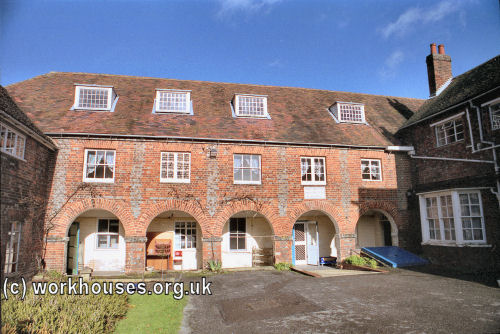
Henley old workhouse, 2000.
© Peter Higginbotham
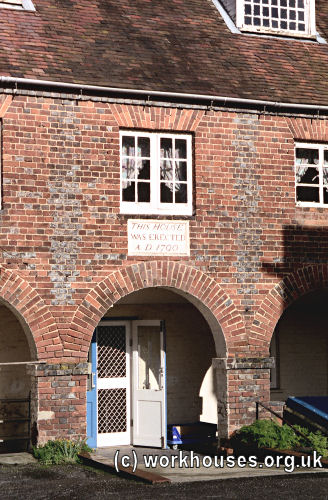
Henley old workhouse entrance , 2000.
© Peter Higginbotham
The workhouse had a "pest-house" which was used for the confinement of infectious cases. In 1794, the 22-year poet Samuel Taylor Coleridge was an unwitting resident of the pest-house. Having run away from Cambridge University where he had accumulated debts, Coleridge joined the Light Dragoons at Reading under the name of Silas Tomkyn Comberbache. When the Dragoons discovered he was totally incapable of riding a horse, he was seconded to Henley and given the job of nursing a fellow recruit who had caught smallpox. The two men were confined in a small chamber for eight days and nights in foul conditions. Coleridge's time in the claustrophobic pesthouse may have contributed to the imagery in the Ancient Mariner.
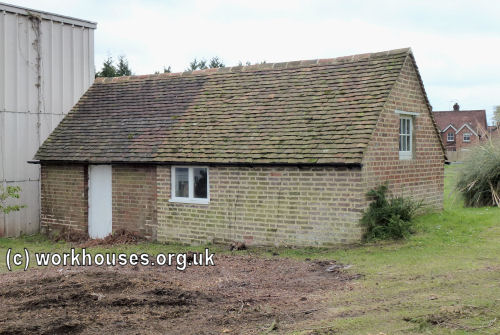
Henley former Pest House, 2014.
© Peter Higginbotham
After 1834
Henley Poor Law Union was formed on 15th June 1835. Its operation was overseen by an elected Board of Guardians, 27 in number, representing its 21 constituent parishes as listed below (figures in brackets indicate numbers of Guardians if more than one):
Oxfordshire:
Bix, Brightwell, Britwell Prior, Britwell Salome, Caversham (2), Checkendon, Cuxham, Eye and Dunsden, Harpsden, Henley (4), Ipsden, Nettlebed, Nuffield, Pishill, Pyrton, Rotherfield Greys (2), Rotherfield Peppard, Shiplake, Swyncombe, Watlington (2).
Later Additions: Badgemore (from 1894), Greys (from 1894), Kidmore (from 1894-1902), Kidmore End (from 1902), Stonor (from 1896).
Berkshire:
Remenham (1835-94).
The population falling within the union at the 1831 census had been 14,651 with parishes ranging in size from Britwell Prior (population 52) to Henley itself (3,618). The average annual poor-rate expenditure for the period 1832-35 had been £12,477 or 17s.0d per head of the population.
At its inaugural meeting on 16th June 1835, the new Henley Board of Guardians appointed a committee to negotiate with the town council on taking over the old workhouse building. The council eventually agreed to lease the building and site for £80 a year. The buildings were enlarged to accommodate 250 at a total cost of around £4000. The additions included a board room and clerk's office, and new receiving wards.
The layout of the workhouse site can be seen on the 1879 map below.
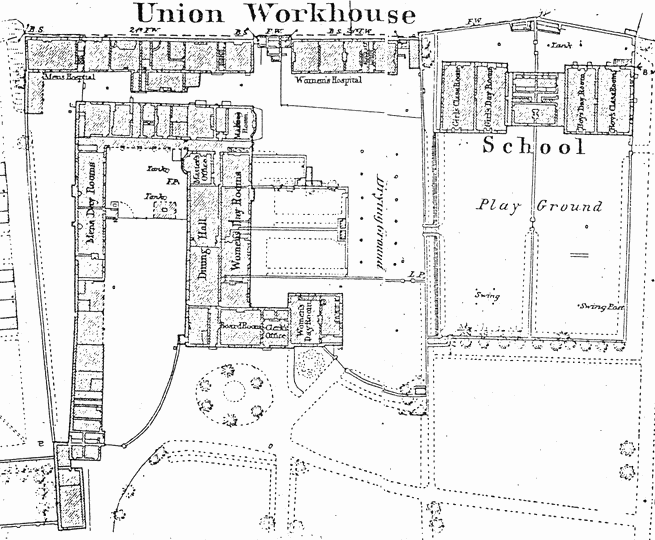
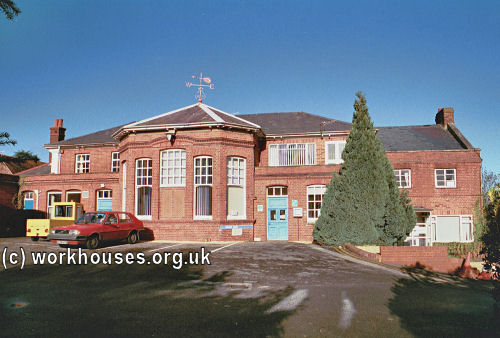
The board-room and clerk's room from the south, 2000.
© Peter Higginbotham
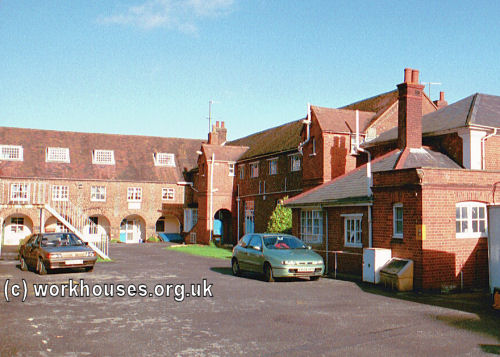
Henley dining-hall block from south-west, 2000.
© Peter Higginbotham
In March 1840, an outbreak of "contagious fever" halted admissions to the workhouse. In the wake of this, an infirmary was built along the northern edge of the site, to designs by Mr Billing, an architect from Reading. The Poor Law Commissioners criticised the plans for having no water closets or bathrooms, stairs that were too steep, and a roof of unsafe construction. In reply, Mr Billing said he could easily modify the plans and include WCs and bathrooms "should they be considered necessary by the Guardians". A tender of £417 for the building's construction from Mr Outhwaite was accepted. The four-ward infirmary was completed by the end of 1841. In 1842, Mr Brooks was appointed Medical Officer for the Henley District at a salary of £110 which was to include attendance at the workhouse and its infirmary which could now accommodate up to 276 inmates. Further improvements were made to the infirmary in 1850, with a paid nurse being employed for the first time at a salary of £10 a year plus rations.
The first master of the union workhouse was William Jackson who was a churchwarden and had previously been a local overseer of the poor. In 1848, the post was taken over by Samuel Mortlock from London, with his wife Ann as workhouse matron and their son, as clerk. Mortlock was to remain master for more than thirty years — a brief account of his life has been researched by Robert Griffiths.
Schoolrooms were added at the east of the site in 1873. These were converted into an infirmary in 1906. New receiving wards and a mortuary were added in around 1909.
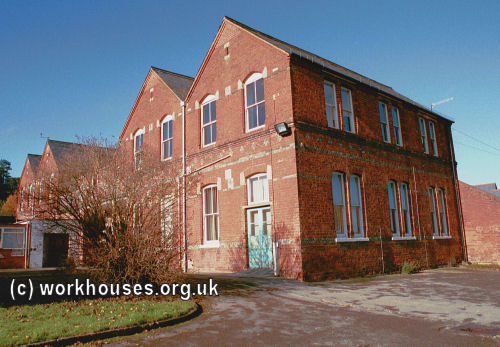
Henley school/infirmary block, 2000.
© Peter Higginbotham
In 1930, the site was taken over by Oxfordshire County Council and became a Public Assistance Institution. In 1948, it joined the new National Health Service as Townlands Hospital, providing general medical facilities for the area.
Following the opening in 2017 of the new Townlands Hospital at the south of the site, the original workhouse and school/infirmary block have been converted to residential use in a development known as Laureate Gardens.
Children's Homes
By 1908, the Henley Union had established a children's homes at 'Radnor House', 35 New Street, Henley, which could accommodate 18 children. Another home was later opened at 'Belmont House', 23 New Street, with 12 places, although this had closed by 1929.
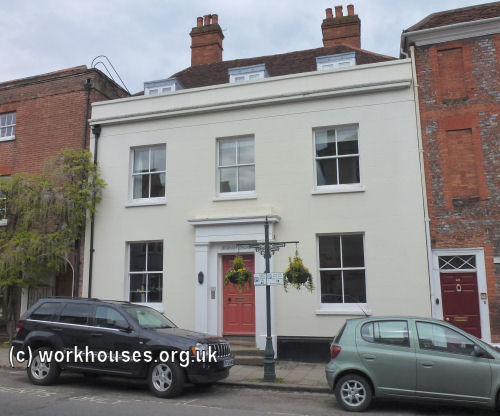
Henley Union former children's home at 23 New Street.
© Peter Higginbotham, 2014.
Staff
- 1881 Census
- Samuel Mortlock, Master 1848-84 — an account of his life by Robert Griffiths.
Inmates
- Long-term workhouse inmates (1861)
- 1881 Census
- 1841 (Henley Census Group)
- 1851 (Henley Census Group)
- 1861 (Henley Census Group)
- 1871 (Henley Census Group)
- 1881 (Henley Census Group)
- 1891 (Henley Census Group)
- 1901 (Henley Census Group)
- 1911 (Henley Census Group)
Records
Note: many repositories impose a closure period of up to 100 years for records identifying individuals. Before travelling a long distance, always check that the records you want to consult will be available.
- Oxfordshire History Centre, St Luke's Church, Temple Road, Cowley, Oxford OX4 2EX. Holdings include Guardians' minutes (1835-1928) etc.
Bibliography
- Alasia, Valerie (2016) Henley Union Workhouse: the Story of Townlands
- Railton, Margaret (1994) Early Medical Services - Berkshire and South Oxfordshire from 1740
Links
- Oxfordshire History Centre, St Luke's Church, Temple Road, Cowley, Oxford OX4 2EX.
Unless otherwise indicated, this page () is copyright Peter Higginbotham. Contents may not be reproduced without permission.


